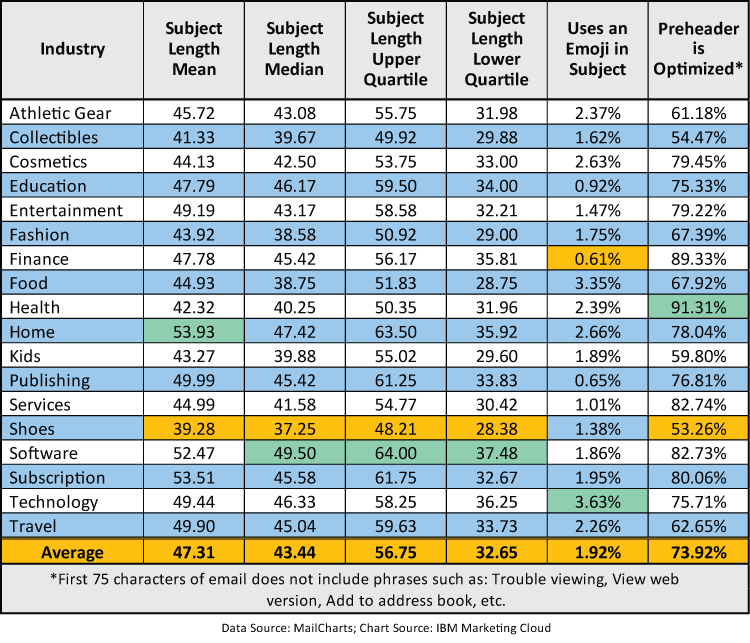After the deliverability and images talk from the past weeks, today we’ll focus one of the most important factors regarding your open rates – the Subject lines and how to craft them.
We won’t be focusing on the copywriting tricks this time – but on the overall suggestions that you need to keep in mind.
Why are Subject Lines important?
Open rates – Subject lines are the main reason why people will open or trash your messages. If they are not enticing enough, people won’t spend their valuable time reading the emails you’re sending them. If you’re constantly tracking your open rates, you’ve probably tested most of the tips we’ve outlined below. Let me know if you have an additional one.
Perception – One of the reasons why people like a subject line is because it talks directly to them – literally and figuratively. They feel that the content inside is what they need and they can’t wait to learn more. People should be excited to read the whole email just from that short subject line. Unfortunately, everybody’s favorite „FREE MONEY FOR YOU“ will immediately arrive in the SPAM folder. If it is delivered at all.
Branding – We constantly receive so many emails, and honestly – the filters catch most of them and they end up in the archive without being read. Because they don’t sound fun or valuable. We’re so used to reading and expressing ourselves in 140 characters, that we now decide if a whole book is going to be interesting by its title. Or, you know – we judge an email by its subject line. What could make you stand out of the crowd is having a personal brand so strong, that it can literally read through your short subject lines. It can be a catchword, it can be a specific symbol you always use (more about that later). Or the way you structure your sentences – if your contacts can identify that „Classic You“, you’ve made it.
Message type – Depending on the goal of your email message, there are different things you might need to consider. I like this guide on Moz’s blog and I think you should bookmark it. A subject line can help the reader identify if it’s important or not, if it contains information or a sales offer. A welcome message might start with [Welcome], a new blog post notification – [New Post], etc.
Subject Lines tips
Apart from branding, you can rely on the following short-short tips to upgrade your subject line performance.
- Length 6 to 8 words – The shorter, the sweeter. Ever received an email with a subject line so long that it feels like the whole email body was actually there? Did it made you open the message? No, right. The best [LINK] performing emails have a subject line that is short and on point. The length of 6-8 words performs best on all devices – usually the whole line can be read and the recipient knows what we’re talking about. Compare the following two:
1. We feel like you made a mistake when you left our awesome strange and pretty product in your shopping cart…
2. Oops… You left your cart still full
Which one will perform better? The second one – it’s not wasting your time and downgrading your IQ. It’s important in email copywriting to keep things as simple as possible – remove as many extra words and adjectives until the text sounds like something you’ll want to open. Though there is some research that suggest a really warm list might respond better to a longer subject line.
- Personalization – To whom it may concern – that’s one of the first mail introductions I learned when I was studying English ages ago. It sounded stupid – it still does. It makes me think of lost mail – it might be delivered and read, but who knows who will be that lucky person to read it.
In the age of email marketing, you need to stand out from the crowd. You need to use the data that you collect from your leads. Not constantly – but do a split test with 2 subject lines that are ALMOST identical. One would have the merge code for the First Name of the person. The open rate AND click through rates are much higher. People feel like it’s more personal because they saw their name in the subject line.
Other ideas:- Use their location – Is it cold/hot now in Alberta/London/Amsterdam? If you have their address – use it smart. Don’t make them feel like they are constantly being watched.
- Use their interest – Is crafting/cooking/painting your thing? When someone visits your website and your content has a clear URI structure based on categories, you can set rules to track their main interests. And use that too ?
- Events they attended – you get the idea. You know your leads and you hopefully know that you need to collect more data from them every step of the way. Smart data segmentation will bring you much closer to success and higher open rates.
- Using emojis – There is still a discussion whether or not emojis will land you in the SPAM folder or the dreaded Promotions tab in Gmail. You need to check if your system will be able to send emojis in the subject line. A workaround is to go to CopyPasteCharacter.com and find an icon that you like. Chances are that Gmail and Inbox would see it as something different and convert it to an emoji. I find that people enjoy it, but it has to be specific. For example, getting flight reminders with the plane emoji is cool and fun. I enjoy it and I can easily identify it as something that is important to me. Don’t forget to ask yourself first – Is this in line with my company and my audience?

Tools
If you love tools, there is one that was brought to my attention recently – SubjectLine. It aims at helping you write better lines and it gives out a score out of 100 and recommendations on how to improve it. I don’t like it – it’s not smart enough just yet. But if you’re new to subject lines – go for it. Try it yourself and let me know what it taught you!
Summary
If you’re dedicated to improving your open rates, optimizing your subject lines is one of the main things to focus on. (The others are deliverability and list engagement levels, but you already know that). The two things that make people decide whether to open an email or not are 1. the sender and 2. the subject line. You can’t cheat your way around that. If people are not excited about what they’ll read, they won’t open the email and might simply archive or trash it.
Oh, and I want to leave you with something fun too – check out the Subject line comics in this post. You’ll love it 🙂

